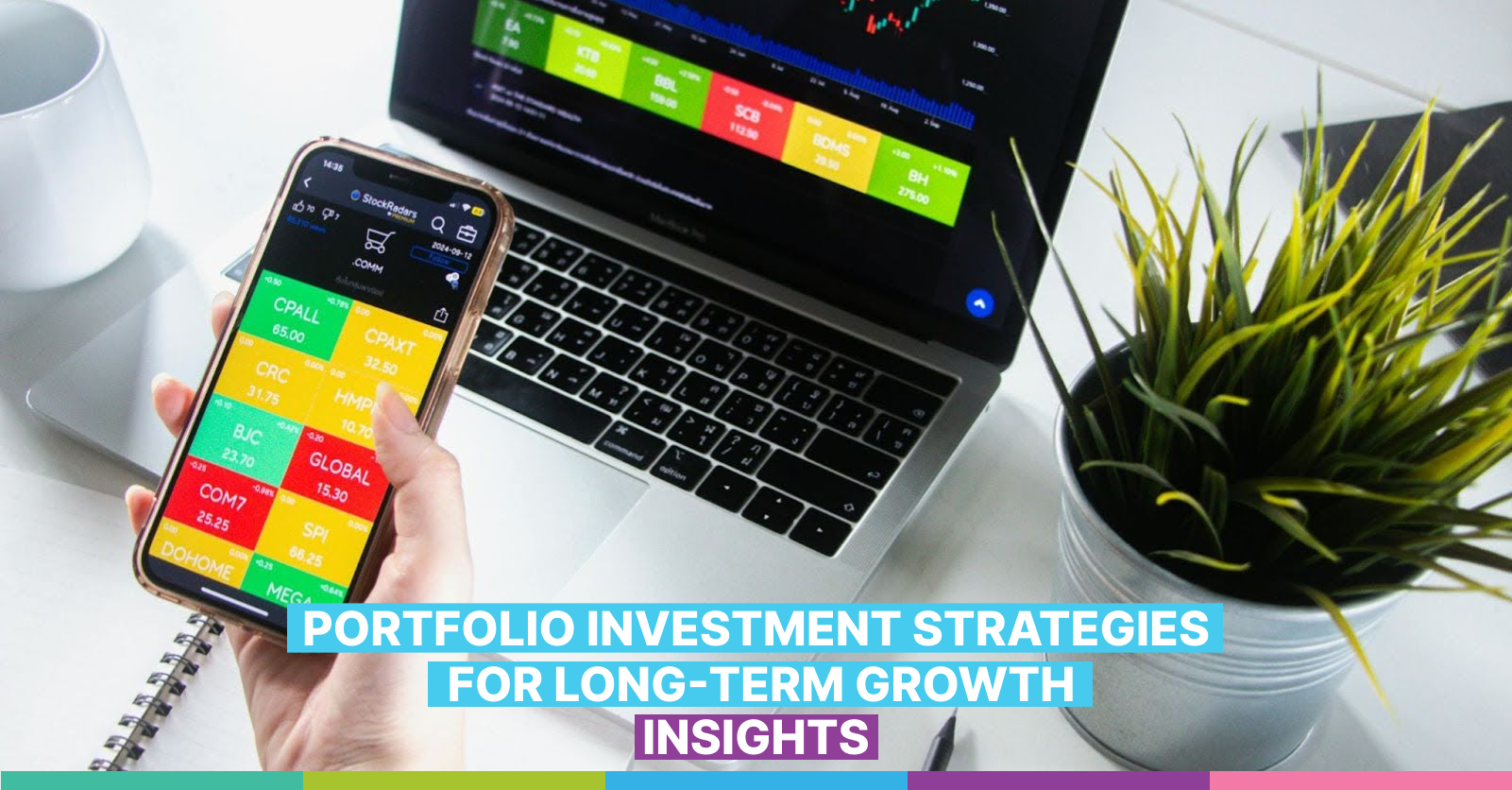
Portfolio Investment Strategies for Long-Term Growth
In today’s fast-paced financial world, the art of long-term investing remains a cornerstone of wealth accumulation. Here, let’s explore various portfolio investment strategies designed to foster sustainable growth over extended periods, offering insights into asset allocation, diversification, and market approaches that have stood the test of time.
Understanding Long-Term Investment
Long-term investment is a strategy that focuses on holding assets for extended periods, typically years or even decades, to achieve significant financial growth. This approach leverages the power of compounding returns and aims to minimise the impact of short-term market volatility.
Why Choose Long-Term Investing?
- Compounding Returns: The longer your money stays invested, the greater the potential for exponential growth through compounding.
- Reduced Volatility: Long-term investors can better weather short-term market fluctuations.
- Lower Costs: Holding investments for extended periods typically reduces transaction fees and taxes.
Key Portfolio Investment Strategies
1. Diversification
Diversification is the cornerstone of risk management in long-term investing. By spreading investments across various asset industries and geographical regions, investors can mitigate the impact of poor performance in any single area.
Asset Classes to Consider:
a. Stocks
b. Bonds
c. Real Estate
d. Commodities
e. Alternative Investments
2. Asset Allocation
Determining the right mix of assets is crucial for long-term success. Your asset allocation should align with your financial goals, risk tolerance, and investment horizon.
3. Dollar-Cost Averaging
This strategy involves investing a fixed amount regularly, regardless of market conditions. It helps to average out the purchase price over time and removes the pressure of trying to time the market perfectly.
4. Value Investing
Popularised by Warren Buffett, value investing focuses on identifying undervalued companies with strong fundamentals and holding them for the long term.
5. Growth Investing
This approach targets companies with high earnings growth potential, often in emerging or innovative sectors.
6. Income Investing
Focusing on assets that generate regular cash flow, such as dividend-paying stocks and bonds, can provide stability and consistent returns.
Building a Long-Term Investment Portfolio

(Source : Pexels)
Step 1: Assess Your Financial Situation
Before diving into investments, evaluate your current financial status, risk tolerance, and long-term goals.
Step 2: Choose Your Asset Mix
Based on your assessment, determine the appropriate allocation between stocks, bonds, and other asset classes.
Step 3: Select Individual Assets
Within each asset class, choose specific investments that align with your strategy. This may include individual stocks, bonds, mutual funds, or ETFs.
Step 4: Monitor and Rebalance
Regularly review your portfolio to ensure it remains aligned with your goals. Rebalance when necessary to maintain your target asset allocation.
Strategies for Different Asset Classes
Stocks
- Blue-Chip Stocks: Invest in established companies with a history of stable growth and dividend payments.
- Growth Stocks: High-growth sectors like technology and healthcare continue to be favourites amongst investors.
- Dividend Stocks: Focus on companies that consistently pay and increase dividends.
Bonds
Government Bonds: Provide stability and guaranteed returns, albeit with lower yields.
Corporate Bonds: Offer higher yields but come with increased risk.
Bond Laddering: Invest in bonds with staggered maturity dates to manage interest rate risk.
Real Estate
REITs: Invest in Real Estate Investment Trusts for exposure to property markets without direct ownership.
Direct Property Investment: Purchase and manage rental properties for long-term appreciation and income.
Leveraging Technology in Long-Term Investing
Robo-Advisors
Automated investment platforms offer low-cost, diversified portfolios tailored to individual goals and risk profiles.
ETFs and Index Funds
These investment vehicles provide broad market exposure at low costs, aligning well with long-term, passive investment strategies.
Risk Management in Long-Term Investing
- Regular Portfolio Review
Conduct annual or bi-annual reviews to ensure your investments remain aligned with your goals.
- Maintaining an Emergency Fund
Keep liquid assets separate from your long-term investments to avoid forced selling during market downturns.
- Understanding Market Cycles
Recognise that markets are cyclical, and maintain a long-term perspective during periods of volatility.
Sustainable and Ethical Investing
Incorporating Environmental, Social, and Governance (ESG) criteria into investment decisions can align portfolios with personal values while potentially enhancing long-term returns.
Common Pitfalls to Avoid
- Overtrading: Excessive buying and selling can erode returns through fees and taxes.
- Chasing Performance: Past performance doesn’t guarantee future results. Avoid making decisions based solely on recent gains.
- Neglecting Diversification: Concentrating investments in a single sector or asset class increases risk.
- Emotional Decision-Making: Panic selling during market downturns can lock in losses and miss out on recoveries.
The Role of Professional Advice

(Source : Pexels)
While many successful investors manage their portfolios independently, seeking professional advice can be beneficial, especially for complex financial situations or when dealing with significant wealth.
Adapting Strategies Over Time
As investors progress through different life stages, their investment strategies should evolve:
Young Investors (20s-30s)
Focus on growth-oriented investments
Maximize contributions to retirement accounts
Take advantage of higher risk tolerance
Mid-Career Investors (40s-50s)
Begin to shift towards a more balanced portfolio
Increase focus on wealth preservation
Consider adding more income-generating assets
Near-Retirement Investors (60s+)
Prioritize capital preservation
Increase allocation to fixed-income securities
Plan for regular income distribution
The Impact of Economic Cycles
Long-term investors should be prepared for various economic conditions:
Bull Markets
Consider taking some profits
Rebalance to maintain target asset allocation
Be cautious of overvaluation
Bear Markets
Stay invested and avoid panic selling
Look for opportunities to buy quality assets at discounted prices
Review and adjust risk tolerance if necessary
Global Diversification
In an interconnected world, geographical diversification can enhance returns and reduce risk:
- Developed Markets: Offer stability and established regulatory frameworks
- Emerging Markets: Provide higher growth potential with increased volatility
- Frontier Markets: Present opportunities for significant returns but with substantial risks
The Future of Long-Term Investing

(Source : Pexels)
As we look ahead, several trends are shaping the landscape of long-term investing:
- Increased Focus on Sustainability: ESG investing is moving from niche to mainstream.
- Technological Disruption: Sectors like AI, renewable energy, and biotechnology offer new investment frontiers.
- Demographic Shifts: Aging populations in developed countries and growing middle classes in emerging markets create new investment themes.
Long-term investment strategies offer a path to sustainable wealth creation, leveraging the power of compounding and market growth over extended periods. By embracing diversification, maintaining discipline, and adapting to changing market conditions, investors can build portfolios capable of withstanding short-term volatility while capturing long-term growth opportunities.
The key to successful long-term investing lies not in predicting the future but in preparing for it. By following time-tested principles and remaining committed to your investment goals, you can navigate the complexities of the financial markets and work towards a secure financial future.
Remember, the journey of a thousand miles begins with a single step. Start your long-term investment journey today, and let the power of compounding work its magic over time.
The article above should not be taken as financial advice. Investments and their corresponding products have risks. Please seek advice from a financial adviser representative before making any investment decisions. In the event that you choose not to seek advice from a financial adviser representative, you should consider whether the investment or product in question is suitable for you.
IPP Financial Advisers Pte Ltd
78 Shenton Way #30-01 Singapore 079120 | Tel: +65 6511 8888 | enquiry@ippfa.com |
IPP Financial Advisers Pte Ltd
78 Shenton Way #30-01 Singapore 079120
Tel: +65 6511 8888 | enquiry@ippfa.com
